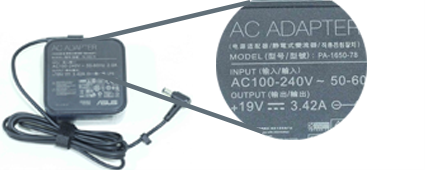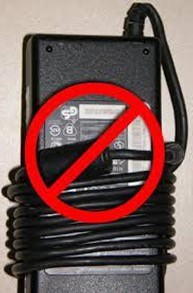AC Adapter Tips
AC Adapter Charger Tips
What is the role of an AC Adapter/Charger and how it works?
In Australia, our power outlets supply 240V (volts), but most laptops only need around 20V (volts) to operate. The main function of a laptop AC Adapter/Charger is to reduce the 240V Power to a particular voltage that suits the laptop (or other devices for that matter). Therefore, it is important to select The correct AC Adapter/Charger if a replacement is required.
How to identify your laptop AC Adapter/Charger.
Every Ac Adapter/Charger has a specific identifying number (Part No), Part Numbers are often printed on a sticker with manufacturer’s logo and details affixed to the AC Adapter/Charger. Some manufacturers identify their AC Adapters/Chargers with the term “Types” (instead of Part No). The easiest way to identify your AC Adapter/Charger, is to locate the part number, type it in to Google and you will get enough information to identify the AC Adapter/Charger. If there is no part number or the sticker has been removed, the only other option is to look for other specifications of your AC Adapter/Charger, and then manually identify your AC Adapter/Charger.
There are 3 identifying aspects to a laptop AC Adapter/Charger when identifying one,
- input details
- output details
- the connector tip that plugs to the laptop’s power jack,
- some of these details can also be found underneath your laptop.
Here is an example of what to look for
Input: 110-240, 50-60Hz (this is regional based, e.g. 240V in Australia)
Output 19V 3.45A (V=Voltage, A=Amps) Wattage is V x A (in this case 19 x 3.45 = 65W)
The only other part that differentiates an AC Adapter/Charger is the size and the type of connector, the best way to identify the connector is to measure the outer diameter of it using tape measure, ruler or calliper, the shape of the connectors are generally brand specific.

What could go wrong with your AC Adapter/Charger.
We often overlook how hard an AC Adapter/Charger has to work to supply power to your Laptop, it is important to understand the strain we put on our AC Adapters/Chargers so we can protect them from overloading or physical damage. Below we have some Dos and Don’ts that help in taking care of your AC Adapter/Charger.
Protect your AC Adapter/Charger from overload
While using your laptop, you will notice your AC Adapter gets warm, this is normal, it is the result of power going through the adapter, reduced from 240V to around 20V. it is worth knowing that the amount of heat generated by the Ac Adapter/Charger is directly related to amount of power it is supplying. If your laptop battery is flat and you are working on the laptop while it is plugged in to the wall socket, you will notice the AC Adapter/Charger gets hot, this is because the AC Adapter/Charger is trying to charge your battery as well as running your laptop. In this case it is better to switch your laptop off for an hour or so, allowing the battery to charge so the AC Adapter has an easier task of just running your laptop.
Protecting your AC Adapter/Charger from physical damage
Consider the following scenarios, we often unplug a hot AC Adapter/Charger, throw it inside a bag and go from one place to another, While the AC Adapter is hot, we hit it against hard objects, or drop it accidentally. These shocks and vibrations often are the reason an AC Adapter/Charger stops working,
Given that the AC Adapters are the most essential part of your laptop, once they stop working your laptop stops working. It is for this reason that we recommend having 2 or more AC Adapters for people who are on the move with their laptop. This means that they don’t have to carry their AC Adapter/Charger all the time, therefore there is less possibility for causing to damage them.
Another common enemy of AC Adapters/Chargers is pulling or yanking them while moving around. When using laptop, often people move from one location to another carrying their laptop while plugged in and when the cord isn’t quite long enough, they unknowingly pull it. This could have a detrimental effect on both the AC Adapter and laptop. It can snap the connector pin that sits inside the laptop and in most cases, it could even break the AC connector inside the laptop.
How to protect your AC Adapters/Chargers against common problems.
- When using your AC Adapter
DO NOT leave adapters on soft flammable surfaces. Adapters get hot when charging and have been known to melt into the carpet and catch fire when left on fluffy quilts or on beds, or when surrounded by a lot of other power cords. The Adapter casing can also melt when left in a confined area.
DO NOT pull on the cord when removing your adapter from your laptop. Always grab the plug securely to remove your adapter.
DO NOT let your AC adapter hang from your laptop with weight pulling on the jack in your laptop. This can damage the plug on the laptop causing charging issues which are often mistaken for a faulty adapter.
DO NOT push your laptop against a wall or use on a severe angle with your AC adapter cord wrapped around behind your laptop, this can damage both the Adapter cable and the Laptop jack.
DO keep the cable away from foot traffic. Many adapters are damaged when people trip on cords sprawled across an office, bedroom, dining room or kitchen floor.
- Storing & Transporting your AC Adapter
When you’re not using your AC adapter, it’s important to store and transport your adapter the correct way to prevent damage.
DO NOT drop the AC Adapter when it is hot, AC Adapters have sensitive components inside them, and while in use these components heat up, Therefore it is important to handle the AC Adapter gently while it is hot.
DO NOT wrap or wind the cord tightly around the adapter. Wrapping tightly not only breaks the copper core inside the cord, but it can also kink and put strain on the cable making it difficult to use, not to mention making it more of a tripping hazard when it’s unrolled to charge your laptop. It can also cause the cord to fray and expose wires where they join to the charger.


DO NOT put your adapter on the top of your laptop while travelling, especially inside your laptop bag. When in a rush, most of us just throw everything randomly in our bags and head out, but if you put items on top of the bag, such as your adapter, you run the risk of these items pushing down on your laptop screen and possibly cracking the LCD/LED panel.
DO wrap your cord loosely, making a neat loop with no tight corners, using a VELCRO strap to keep the cables secure tucked away from harm, as shown in the above picture.
DO keep your adapter in a cool, dry, clean environment away from moisture and dust.

